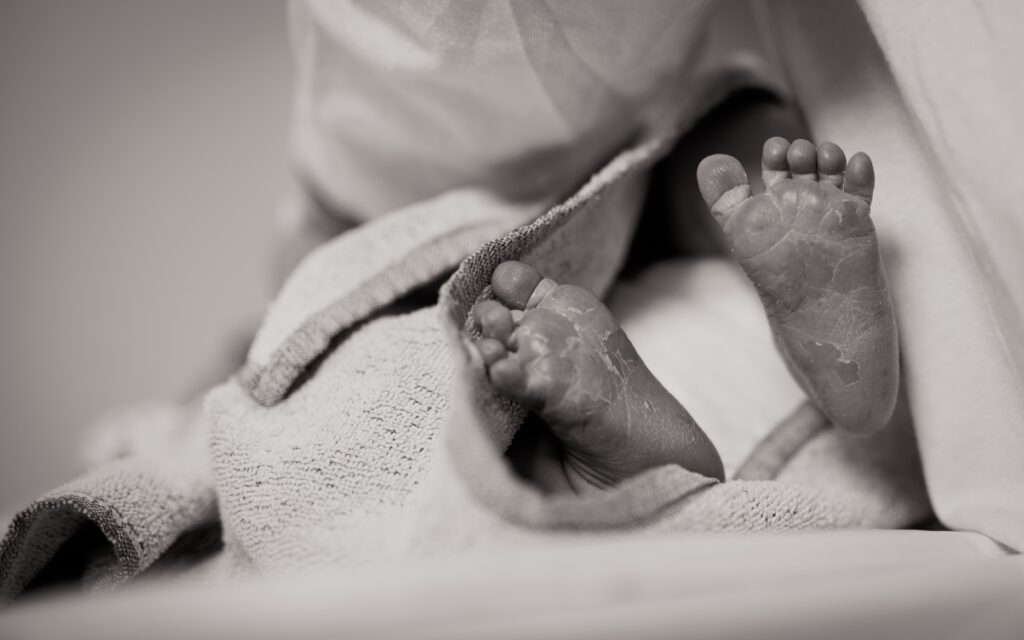Childbirth is the final stage of pregnancy, in which the mother gives birth to her baby or babies. Many consider childbirth a trying yet joyous time for the families and loved ones of the baby, the mother, the father, and all other people involved. Each childbirth is a unique experience that changes depending on a number of factors including the mother, the location of birth, as well as the choice to incorporate anesthetics. Learning about childbirth will help expecting mothers, family members and close friends be prepared and more relaxed during this process.

Table of Contents
Four Stages of Childbirth
There are four stages of childbirth and the length and experience of each phase is dependent on the expecting mother.
First Stage
There are three individual phases that take place during this first stage of childbirth. The first part of the initial stage of childbirth is referred to as the latent phase or the early labor phase. During the latent phase, the expecting mother begins to have uterine contractions.1 The early labor phase is complete when the cervix is dilated to 3 centimeters.2 It is important to stay relaxed during this phase, as there are still a number of hours before the child will be born. During the early phase, the mother should drink plenty of water and be prepared to remain in this phase for 8 to 12 hours.2 However, it is important to note that these contractions are different from Braxton Hicks contractions, which typically occur at 26 weeks into the pregnancy. Braxton Hicks contractions are mild contractions that are irregular and infrequent.3 The purpose of Braxton Hicks contractions is to prepare the female’s muscles to give birth. It is crucial to know and understand the difference in contractions as they are an important indicator of the stage of pregnancy the expecting mother is in. Cervical effacement, the thinning of the cervix, is typically complete or near completion by the end of the latent phase of the first stage of childbirth.8 Cervical effacement is measured in percentages, meaning that if effacement is at 75%, then the expecting mother is three quarters of the way to birth.8 The closer the cervical effacement is to 100%, the closer labor is.8
The second part of the first stage of childbirth is the active phase. When the active phase begins it is time to go to the hospital or location where the mother intends to give birth. A strong support system is crucial, as the female will experience taxing physical and emotional stress. During the active phase, the cervix will continue to dilate between 4 and 7 centimeters and will typically last from three to five hours.2 Other people in the room should give the mother their full attention and provide her with positive and encouraging statements. It may be helpful to massage the soon to be mother and make her feel as comfortable as possible.
The third and final phase of the first stage of childbirth is the transition phase. The transition phase lasts between 30 minutes and 2 hours, and the cervix will dilate from 8 to 10 centimeters.2 Gas, vomiting, hot flashes, and nausea are common during the transition phase, making it the hardest of the three parts of the first stage.
Second Stage
The second stage, referred to as the fetal expulsion phase, occurs when the cervix is fully dilated. During the fetal expulsion stage, the fetus exits the birth canal. This stage usually lasts between 10 and 12 minutes. In a typical childbirth, the fetus’s head breaches first, followed by the rest of the body. It is during the fetal expulsion phase that the female begins to push to assist the fetus while it exits her body. It is also important to remember that each childbirth is unique and will not always follow this process or timeline. There are a number of factors, such as fetal size and anesthesia, that can affect the length of time in this stage.
Third Stage
The third stage of childbirth is also known as the placental expulsion phase, where the placenta detaches from the uterus and exits the female. The placental expulsion phase typically takes between 10 to 12 minutes and can occur naturally or can be extracted medically.4 However, the World Health Organization recommends an active management or medically assisted expulsion of the placenta in order to decrease the chances of postpartum hemorrhaging.4 The final part of the third stage is the cutting of the umbilical cord.
Fourth Stage
The fourth stage is often an overlooked phase of childbirth. This stage begins once the child is born and lasts until approximately six weeks post birth. During this period, the mother’s body begins to return to normal. The return to a non-pregnant state includes the uterus size and hormone levels returning to pre-birth levels. The mother should be monitored for 24 hours after birth; during this time, doctors check the mother’s heart rate, blood pressure, and temperature, and they will sometimes administer routine blood tests.9 It is normal for the mother to feel cramps following the birth of her child, and she can also expect vaginal discharge for the next few weeks. Experts suggest that skin-to-skin contact between the mother and her child should occur as soon as possible, as it has been demonstrated to have many positive benefits, including a closer connection between the child and their mother.9 It is typical for the mother and the child to stay in the hospital for about 24 hours after birth, if the childbirth occurs at the hospital. This is to ensure that the mother and her child remain in expert care during this crucial time.9
Preparing for Childbirth
Preparation is a critical aspect of ensuring the smoothest most efficient childbirth possible. As soon as a female learns she is pregnant, finding and selecting an obstetrician/gynecologist (OB/GYN) that she feels comfortable with and is confident in is crucial. The OB/GYN will be present during all stages of the pregnancy and can make a true difference in the quality, ease, and success of the childbirth.
If the mother chooses to have her child at a hospital, working with the OB/GYN to find the right hospital is also an important decision. Most often, the OB/GYN will work with specific hospitals where they will be fully equipped to help the expecting mother deliver her baby.
A few weeks prior to the due date, putting together a “Go Bag” can be helpful for when the delivery day occurs. A “Go Bag” should consist of a governmental issued ID, an insurance card, and a birth plan. Toiletries, sanitary pads, and comfortable clothes such as a bathrobe, socks, underwear, and a sweater should also be included in the bag. A partner should also pack their own bag which may include money (cash and credit), snacks, entertainment such as a book or a movie, a camera/videorecorder, toiletries and phone chargers. Outfits for the mother, her partner, and their new child to go home in should be included to the “Go Bag.” Having these bags prepacked will take some stress away from the moment of actually leaving to go to the hospital.
Making dry practice runs to the hospital or other planned birthing locations from common places the mother spends time at will also be helpful. Driving to the hospital from the mother’s home multiple times and finding where to park will remove unneeded anxiety from the mother on delivery day. Bringing a towel and a trash bag for the car ride is also suggested in case the mother’s water breaks, or if she becomes nauseous and needs to vomit. Packing a car seat for the return trip from the hospital is extremely important.
Having the proper paperwork ready in the “Go Bag” will help to streamline the child birth process. Government issued identification for both parents, up-to-date insurance cards, contact lists of family members and friends, a birth plan, and any hospital confirmation should be included in the bag.
Reading books and watching videos about childbirth can often times help expecting mothers be prepared for the process of childbirth. Knowing what to expect before going through childbirth can have a positive impact on expecting mothers; preparation can help reduce the chances of an unexpected surprise and allow mothers and their partners to ready themselves for this life-changing moment.
Expecting mothers and their families can prepare for the newborn ahead of time to make the transition from the hospital to home as smooth as possible. This includes buying baby clothes, diapers, baby food, and blankets for the newborn. The purpose of this preparation is to eliminate as much pressure and anxiety from the expecting mother as possible once she delivers.

Location for Childbirth
Childbirth has taken place in almost all terrains and situations throughout the world. In developed countries, hospitals are the most common place for childbirth to take place. However, other locations such as birthing centers, the homes of expecting mothers, and water birthing tubs are also common locations for childbirth.
Hospitals
Hospitals are the most common and recommended location for delivering a child. While a majority of pregnancies do not have any complications, it is impossible to predict with certainly whether or not something will go wrong. Hospitals are equipped with experts in childbirth and natal care, a team of specialized doctors who focus solely on infants, and have the equipment and medication necessary to treat newborn children and their mothers. Delivering a child in the hospital may be costly for some mothers and families, so it is best to check with insurance companies and plan ahead in order to pay for hospital costs and services.
Birthing Centers
Birthing centers are a low-tech alternative to hospitals and should only be considered for healthy females with a low risk of birth complications. At birthing centers, there are no intravenous drips (IVs) or electronic fetal monitoring, and the expecting mothers are assisted by midwifes and nurses. Some of the benefits of birthing centers include lower costs, a shorter stay, and the mother’s pick of who is in the room with her. Birthing centers are usually in close proximity to a hospital in case any complications arise.5
Birthing at Home
Birthing at the mother’s home is only an option for extremely healthy expectant mothers, who have no worrisome medical history. Having the childbirth at home can give the mother more control over the situation and help her feel more comfortable. However, if any complications do arise, the expecting mother must go to the hospital to ensure she has the best care. Many insurance companies do not cover the costs of in-home births; therefore, expecting mothers should contact their insurance companies for more accurate information.6
Water Births
In a water birth, the mother gives birth in a tub of warm water. It is up to the expecting mother to choose whether she wants to get out of the water for the actual delivery or to stay in the water. Some argue that because the fetus has been in amniotic fluid for nine months, the water birth provides an environment that they are used to. Water births can be risky as there is an increased chance of the baby drowning or other complications that may arise during childbirth.7

Pain Management for Childbirth
Childbirth is a prolonged process that can be painful for mothers giving birth. There are multiple ways to manage the pain during childbirth and it is best to consult with your OB/GYN to create a management plan that is most suitable for the expecting mother and the health of her newborn baby. There are two distinct methods of pain management: pharmaceutical and non-pharmaceutical.
Pharmaceutical Pain Management
A common form of pharmaceutical pain management is an epidural block. An epidural block is a local anesthetic that is administer just prior to delivery.10 Epidurals alleviate pain in the lower body of the mother, can be used throughout the pregnancy, will keep the mother alert and awake during the pregnancy, and has little effect on the newborn baby.10
A spinal block is another type of regional analgesia that is given in one dose and provides total pain relief in the lower part of the body for about one or two hours.10 Spinal blocks typically do not have any effect on the baby.10
The final type of pharmaceuticals typically used during labor include a variety of narcotics that help manage pain during the labor.10 The narcotics can be administered through a needle directly into a muscle or through an intravenous line. Narcotics can take effect within just a few minutes and doses can be managed throughout the pregnancy.10
Non-Pharmaceutical Pain Management
Many expecting mothers opt-out of pharmaceutical pain management options when giving birth. Instead, these mothers rely on non-pharmaceutical pain management techniques. Many Lamaze classes instruct expecting mothers on non-pharmaceutical options. These options include acupressure, massage, hot/cold therapy, guided imagery, music, and breathing techniques.11 Each expecting mother is unique so it is important to tailor a plan based on the mother’s wishes. The expecting mother can work with a Lamaze class or with loved ones and can research each option to see what she believes will be most beneficial during labor. Even if the mother ultimately chooses to utilize pharmaceutical pain management options during labor, using non-pharmaceutical options as well can still be helpful. Practicing the non-pharmaceutical pain management options prior to birth may help the expecting mother feel more comfortable as her due date approaches.
C-Section
While a majority of childbirths are natural, some expecting mothers plan to or are forced to have a cesarean delivery, also known as C-section. According to the Centers for Disease Control, in 2014 there were a total of 2,699,951 vaginal deliveries in the United States, while there were 1,284,551 Cesarean deliveries.12 A Cesarean delivery is a surgical procedure in which doctors cut into the lower abdominal of the mother to extract the baby from the womb. There are a number of reasons why a mother would have a Cesarean section, including the following:
- The labor is taking too long and not going as scheduled
- The mother has more than one baby including twins and triplets
- The baby is too large for natural childbirth
- The mother is going through serious health complications
- The position of the baby will complicate the childbirth13
The Cesarean section is relatively safe for both the mother and her child. However, as with any type of surgery, there is always the chance of complications. A Cesarean section can also create issues for females who try to get pregnant with an additional baby.13
Complications During Labor
While a majority of births go according to plan and have no complications, there are a number of issues that can occur during labor.14 One of the most common complications that may take place during labor is when the labor does not progress through the stages as planned. This issue occurs when the mother’s cervix is not dilated enough.14 Medication can help move this process along, and if that fails, then a Cesarean delivery might be needed. Another complication that may occur during labor is when the baby has an abnormal heart rate.14 This may be caused by the positioning of the baby in the womb so the OB/GYN may ask the mother to shift positions in order to increase the blood flow to the baby.14 Perinatal asphyxia occurs when the baby does not receive enough oxygen during the labor process. Depending on what stage this occurs, the OB/GYN might have to do a Cesarean section or preform an episiotomy.14 An episiotomy is when the OB/GYN makes a surgical incision between the vagina and anus in order to widen the vaginal opening, making it easier to deliver the baby.14 The episiotomy is also used when the labor goes into shoulder dystocia, where the infant’s head has exited the vagina but the shoulders are stuckinside.14 Excessive bleeding is another possible issue that may result from tears in the uterus. Due to the fact that complications during labor can occur at any moment, and without warning, it is advised that childbirth occurs at a hospital.14
After Childbirth
As soon as the baby is delivered, the mother may opt for nurses to wash and check on the newborn or may request to be the first person to hold her newborn baby.15 Physical contact between the mother and the child is crucial, especially during the first hour after childbirth.15 It is important to communicate your wishes to the OBGYN and the birthing staff so that they can make the proper accommodations. Soon after the baby is delivered, eye drops are placed in the baby’s eyes to help prevent infection.15 Breastfeeding is also common shortly after the baby is born. Once the mother has delivered the baby and the placenta is released from the vagina, mothers and their babies are often taken to a recovery room where they are often greeted by their family.15 If family and friends are not present, nurses are always available to care for the baby as the mother recovers from the strenuous toll of childbirth.15

Breastfeeding can be a challenging task and a lactation consult may be scheduled in order to coach and assist the new mother while she breastfeeds her child the first time.15 A mother and her baby typically spend one to two days after labor in the hospital for routine checks if it was a natural birth. If the birth was performed via a Caesarean section, then mothers can expect to stay in the hospital for up to four days.15 Before the mother and her baby are allowed to go home, they both receive medical exams by doctors to ensure their health. The parents of the newborn must also sign a birth certificate prior to leaving the hospital, even if the baby is not named at the time of the signatures.15 Someone other than the mother should drive her and her baby home, as the mother may still be experiencing adverse side effects of childbirth. It is imperative that the baby be placed in a certified car seat, and it is vital to ensure the car seat is installed properly.15
The mother should schedule a pediatric checkup for the newborn about a week after the baby is born so that a physician can perform a routine exam.15 While parenting may seem daunting, there are a number of incredible resources to help new parents. Books, online research, online forums, pamphlets, and support groups may help people navigating the new world of parenting. It is important to remember that each mother and her child are unique and, therefore, there is no set formula to parenting.
Concluding Remarks
Childbirth is the culmination of the pregnancy and the beginning of a new and exciting chapter in the mother’s and baby’s life. Learning more about childbirth before it actually occurs can remove and reduce some of the stress associated with childbirth, which can help lead to a safer and healthier child birthing process.
References
- “Latent Phase of Labor.” Latent Phase of Labor. N.p., n.d. Web. 21 Jan. 2017.
- “Stages of Labor: Early Labor, Active Labor & Transition Stage.” American Pregnancy Association. N.p., 05 Nov. 2016. Web. 21 Jan. 2017.
- Murray, Linda, Leah Hennen, and Jim Scott. The Babycenter Essential Guide to Pregnancy and Birth: Expert Advice and Real-world Wisdom from the Top Pregnancy and Parenting Resource. Emmaus, Penn.: Rodale, 2005. Print.
- Jangsten, E., L-Ã Mattsson, I. Lyckestam, A-L HellstrÃm, and M. Berg. “A Comparison of Active Management and Expectant Management of the Third Stage of Labour: A Swedish Randomised Controlled Trial.” BJOG: An International Journal of Obstetrics & Gynaecology 118.3 (2010): 362-69. Web. 21 Jan. 2017.
- “Birth Centers: Alternatives to Hospitals.” Baby Center. Baby Center, n.d. Web. 21 Jan. 2017.
- Reviewed by the BabyCenter Medical Advisory Board. “Planned Home Birth.” BabyCenter. N.p., 20 Jan. 2017. Web. 21 Jan. 2017.
- “Water Birth: Benefits and Potential Risks.” American Pregnancy Association. N.p., 19 May 2016. Web. 21 Jan. 2017.
- “Effacement.” American Pregnancy Association. N.p., 04 Dec. 2015. Web. 27 Feb. 2017.
- Romano, Mattea, Alessandra Cacciatore, Rosalba Giordano, and Beatrice La Rosa. “Postpartum Period: Three Distinct but Continuous Phases.” Journal of Prenatal Medicine. CIC Edizioni Internazionali, 2010. Web. 27 Feb. 2017.
- “Labor and Delivery: Pain Medications.” Mayo Clinic. N.p., n.d. Web. 27 Feb. 2017.
- Brown, Sylvia T., Carol Douglas, and LeeAnn Plaster Flood. “Women’s Evaluation of Intrapartum Nonpharmacological Pain Relief Methods Used during Labor.” The Journal of Perinatal Education. U.S. National Library of Medicine, 2001. Web. 08 Mar. 2017.
- “Births – Method of Delivery.” Centers for Disease Control and Prevention. Centers for Disease Control and Prevention, 07 Oct. 2016. Web. 27 Feb. 2017.
- “Cesarean Section | C Section | MedlinePlus.” MedlinePlus Trusted Health Information for You. N.p., n.d. Web. 27 Feb. 2017.
- National Institutes of Health. U.S. Department of Health and Human Services, n.d. Web. 27 Feb. 2017.
- Admin-mdp. “What to Expect After Giving Birth in a Hospital.” Fit Pregnancy and Baby. Fit Pregnancy and Baby, 03 Oct. 2016. Web. 27 Feb. 2017.
Last Updated: 14 March 2017.
